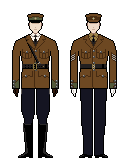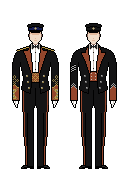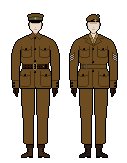Uniforms of the Royal Army (Great Nortend)
The Royal Army of Great Nortend, formally known as His Majesty's Officers and Men at Arms, are well known for their distinctive uniforms and dress in Great Nortend and beyond. The uniforms of the Royal Army exist in seven dress orders, from the most elaborate full dress to the most informal field dress.
Facing colours
Each regiment and corps of the Royal Army has its own facing colour, which is used on fabric for the linings and trim of uniform tunics, coats and head-dress. Some regiments have two or even three facing colours, resulting usually in a striped pattern.
- Scarlet: 2nd (Royal Enley), 3rd (and White) (King's Royal Teyshire), 13th (and Yellow) (Queen Catherine's), 22nd (and Black) (Prince of Leaton's), 41st (and Orange and White) (Queen's Own)
- Crimson: 9th (Norsax Fusiliers), 29th (Red of Gortland), 47th (Duke of Essingford's)
- Red: 15th (Prince of Rhise's Own), 28th (and Orange) (East Aceshire), 49th (Northern Light), Hambrian Guards
- Deep purple: 19th (Harvickshire)
- Maroon: 50th (North Essingford and Plumey)
- Orange: 21st (Margrave of Bine's), 28th (and Red) (East Aceshire)
- Pale orange: 24th (Earl of Roseham's)
- Amber yellow: 7th (Faunslaughter),
- Yellow: 6th (and White) (Queen's Bentshire), 25th (and Black) (Northannering), 38th (with Green) (Prince of Gervis's), King's Own Guards
- Green yellow: 27th (Eamshire)
- Buff: 5th (Cranshire), 26th (Murish Fusiliers)
- Brown: 31st (and White) (Chessboards), 46th (New North Barminstershire)
- Pale green: 17th (Monmorians), 43rd (and White) (Duke of Alvington's)
- Beech green: 18th (Plumwelders), City Guards
- Rhighton green: 36th (King's Rhighton)
- New green: 20th (King's Own Foresters), 42nd (and Light grey) (Igoddal)
- Dark green: 12th (North Larkshire), 37th (and White) (Poltland)
- Egg blue: 10th (Great Walecester), Royal Army Nursing Corps
- Blue: 11th (and White) (Duke of Towshire's), 39th (and Gold) (High Alpiners)
- Royal blue: 17th (Lasmere Marchers), 33rd (Earl of Barminster's), Queen's Own Guards
- Dark blue: 4th (Prince Andrew's South Aceshire), 24th (and White) (Duke of Fivewells's), 45th (Prince of Dunricia's)
- Purple: Royal Army Chaplains' Corps
- Light Grey: 34th (East Gortland), 42nd (and New green) (Igoddal)
- Middle Grey: 14th (Gardolian)
- Black: 8th (Barard), 22nd (and Scarlet) (Prince of Leaton's), 25th (and Yellow) (Northannering)
- White: 1st (Royal Narland), 3rd (and Scarlet) (King's Royal Teyshire), 6th (and Yellow) (Queen's Bentshire), 11th (and Blue) (Duke of Towshire's), 24th (and Dark blue) (Duke of Fivewells's), 31st (and Brown) (Chessboards), 32nd (Duke of Morney's), 35th (Duke of Limmes's), 37th (and Dark green) (Poltland), 41st (and Scarlet and Orange) (Suthrepourdeland), 43rd (and Pale green) (Duke of Alvington's)
Dress Order I: Full dress
Full dress is the most ceremonial, elaborate and formal day dress available. It is in much of the same pattern as was used in the 19th century, when uniforms were standardised, and has changed very little since. Full dress is colloquially known as 'blues and whites', as the main colour for infantry regiments and most service corps is a dark , almost black, blue. Red is used in certain regiments, mostly cavalry regiments, as well as by some foot guards. Dark green is used by riflers. Dark grey is used by some service corps.
Full dress consists, it its most general form, a coloured woollen coat, polished belt (men) or sashes (NCOs and officers), head-dress, gaitered-trousers (men) or overalls (officers), and dress boots (men) or riding boots (officers). Officers also wear gold epaulettes bearing their rank insignia. All regular serving soldiers are issued with full dress uniform coats, belts, gloves and boots; however, ceremonial head-dress are only normally issued when needed, except for those with regular ceremonial duties. Officers are required to acquire their own items of dress.
Full dress is regularly worn by the foot guard regiments, horse guards regiments and army bands. It is also commonly worn at military weddings, funerals, ceremonial occasions, state occasions and public occasions. The dress order is distinctive for its white trousers or overalls, which are worn by most regiments, although some wear blue, black or red. The coat is the same as worn in Dress Order II.
Head-dress differs between men and officers, and between regiments. Most ordinary infantry regiments wear a standardised leather pointed helm as their full dress head-dress, in gold for officers and silver for men, though officers of colonel rank and above wear cocked bicornes. Some northern regiments wear what is known as a wool helm, which is a helmet trimmed with lambswool. Cuirassiers wear an open helm. Grenadiers wear a traditional grenadier's cap trimmed in black bear fur, colloquially known as a bearskin. Hunters and artillery regiments wear busbies whilst dragoon regiments wear silver and gold-plated helmets. Riflers wear either shako-style helmets or pointed helms. Lancer regiments usually wear czapki. Service corps without any other specialised head-dress wear a cloth-covered cork helmet, similar in design to the pointed helm without the point.
Dress Order II: Undress
Undress originated in the late 19th century as a more informal version of full dress. It consists of the same tunic or coat and boots worn in full dress; however, it includes different trousers or overalls and accoutrements.
The main difference in appearance is the dark blue trousers (men) or overalls (officers), in lieu of the white of full dress. For officers, epaulettes are replaced with shoulder boards, and the shoulder and waist sashes replaced with a Sam Browne belt. For men, the polished leather belt is replaced with a plain leather belt, as worn in Dress Order III, duty dress. The coloured collar of full dress is replaced with a plain collar. Head-dress is also mostly standardised to a peaked cap, although some regiments retain their distinctive head-dress.
In winter, a greatcoat is worn over the tunic or coat. A frock coat may be worn by officers when not on parade, and riding boots exchanged for service boots worn with duty dress.
Undress is the normal formal dress of the Royal Army, and is generally worn on Sundays, formal occasions and as walking-out dress. All regular serving men are issued with undress items, the tunic whereof ought to be altered to fit. Officers are required to acquire their own items of dress.
In tropical regions, a lighter version is issued, known as Dress Order IIB. It is made from cotton and linen, and the officer's coat is shorter.
Dress Order III: Duty dress
Duty dress is the common day-to-day dress for the Royal Army, colloquially known as 'brown order'. It was introduced in the early 20th century as a simpler and more practical dress for day-to-day use than compared to either Dress Order I or Dress Order II.
It consists of an open collared khaki-brown serge tunic (men) or coat (officers). A shirt with detachable collars, white for officers and dull khaki for men, is worn underneath, with a tie in regimental colours for officers and in dark brown for men. Darker brown trousers (men and officers) or overalls (officers optional) are worn, with service boots for the former and riding boots for the latter. A Sam Browne belt is worn by most officers and a plain leather belt by men. Head-dress is usually a peaked cap for all ranks and officers, although a beret may be authorised for some men.
Duty dress is normally worn by all ranks and officers on barracks on all days except Sundays (whereon undress would be worn for chapel or church). One set is issued to all militiamen and national servicemen, and two sets for regular soldiers. Officers must acquire themselves items of dress. Duty dress generally may not be worn walking-out by regular soldiers, who must wear undress. Duty dress is commonly worn on field exercises in Great Nortend, instead of Dress Order VII, field dress.
Dress Order IV: Evening dress
Evening dress is the evening-time equivalent to Dress Order I, full dress. It is only very rarely worn, generally for evening court or society occasions in public where mess dress would be inappropriately informal. Evening dress is not issued to men unless they require it, such as for non-commissioned officers of a regiment attached to an aristocratic household. Officers must acquire evening dress items themselves.
Evening dress is somewhat similar to full dress, except that an wool barathea open collar tailcoat pattern is substituted in lieu of the closed collar officer's coat or tunic. A stiff, pleated shirt is worn with detachable wing collar and white bow tie. Waist-sashes are worn inside the coat and no shoulder sashes are worn by officers. Men wear a white waistcoat. The head-dress worn by most regiments is the formal cocked hat, and black breeches and black hosen are worn with buckled court shoes instead of the white trousers, overalls and boots. Some regiments wear the pointed helm.
Dress Order V: Mess dress
Mess dress is an evening order of dress worn by men and officers at evening messes or functions. It is issued to senior non-commissioned officers as a matter of course; however, junior non-commissioned officers and privates will either be required to hire mess dress or wear their Dress Order I or Dress Order II uniform instead.
A mess jacket with short tails, is worn, either with a standing collar and cut away at the front similar to a coatee (VA), or an open front coat similar to a civilian white-tie tailcoat albeit without tails (VB). The former design is typical for cavalry or mounted regiments and the latter for other regiments. Regimental facing colours are highly visible in mess dress on both cuffs, collars, inner lining and lapels. The jacket is coloured according to the regiment's Dress Order I, full dress colours. Most regiments therefore have dark blue mess dress, with some scarlet and some dark green or grey.
Waist-coats are worn underneath the mess jacket, in regimental colours. They are highly embroidered in often gold or silver wire. Tight-fitting overalls are worn by both men and officers with mess dress, along with dress boots. For mess jackets in the open front style, starched wing collars are worn with the pleated shirt, with black bow ties.
Dress Order VI: Special dress
Special dress covers a number of specialised uniform dress orders for different purposes.
Dress Order VIA: Ward dress
Ward dress is the dress order for nurses, sisters and matrons of the Royal Army Nursing Corps when in hospital wards. It consists of in summer a light blue ankle-long gown with white linen apron. A white tippet cape is optional. In winter, a thick blue woollen dress is worn with apron. Nurses wear a short linen nursing cap, whilst sisters and matrons wear a large square linen veil. A red shoulder-length tippet cape is worn over the apron and dress by matrons in ward whilst a grey tippet cape with red edging is worn by sisters. Grey dresses are worn by reserve nurses in lieu of the blue for regular nurses, with an optional white tippet cape with red edging.
All nurses, sisters and matrons wear starched detachable collars and cuffs, with matrons and sisters wearing standing collars.
Dress Order VIB: Legal dress
Legal dress is worn by army advocates in courts martial. It is the same as Dress Order II, undress, except with a legal gown and advocate's wig worn, as well as black breeches and black hosen worn with buckled shoes.
Dress Order VII: Field dress
Field dress is worn in the field as a form of combat uniform. The most common form is plain khaki-green, which is suitable for wear in temperate woodland and pasture environments. At its most basic level, soldiers wear a linen or flannel (depending on weather) long-sleeved shirt, woollen blouson, and woollen trousers, worn with the service cap, beret or helmet. Brown rough-out boots (polished with brown polish) with woollen socks are worn with field dress, and trousers are wrapped with short puttees. In the cold, woollen pullovers are issued. In hotter climates, cotton drill or linen clothing may be issued.
This page is written in Erbonian English, which has its own spelling conventions (colour, travelled, centre, realise, instal, sobre, shew, artefact), and some terms that are used in it may be different or absent from other varieties of English. |










